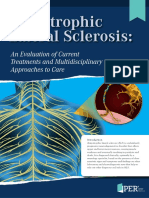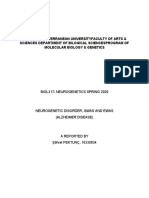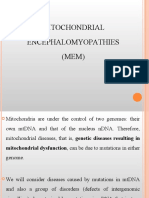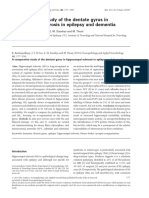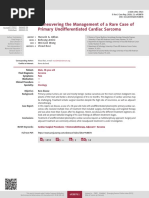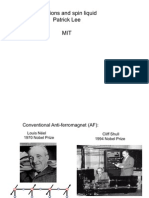Nascimento Et Al. - 2012 - Adrenoleukodystrophy A Forgotten Diagnosis in Children With Primary Addison' S Disease
Nascimento Et Al. - 2012 - Adrenoleukodystrophy A Forgotten Diagnosis in Children With Primary Addison' S Disease
Uploaded by
flashjetCopyright:
Available Formats
Nascimento Et Al. - 2012 - Adrenoleukodystrophy A Forgotten Diagnosis in Children With Primary Addison' S Disease
Nascimento Et Al. - 2012 - Adrenoleukodystrophy A Forgotten Diagnosis in Children With Primary Addison' S Disease
Uploaded by
flashjetOriginal Title
Copyright
Available Formats
Share this document
Did you find this document useful?
Is this content inappropriate?
Copyright:
Available Formats
Nascimento Et Al. - 2012 - Adrenoleukodystrophy A Forgotten Diagnosis in Children With Primary Addison' S Disease
Nascimento Et Al. - 2012 - Adrenoleukodystrophy A Forgotten Diagnosis in Children With Primary Addison' S Disease
Uploaded by
flashjetCopyright:
Available Formats
Reminder of important clinical lesson
Adrenoleukodystrophy: a forgotten diagnosis in children with
primary Addison’s disease
Marta Nascimento, Nádia Rodrigues, Filipa Espada, Marcelo Fonseca
Department of Pediatrics, Hospital Pedro Hispano, Matosinhos, Portugal
Correspondence to Dr Marta Nascimento, marta.r.n.nascimento@gmail.com
Summary
The X linked adrenoleukodystrophy (X-ALD) is a peroxisomal disease caused by defects of the ABCD1 gene on chromosome Xq28 leading
to accumulation of very long chain fatty acids (VLCFA), progressive demyelination and adrenal insufficiency. An 8-year-old boy was referred
to our paediatric endocrinology clinic due to fatigue and hyperpigmentation with onset at 2-years old. Blood tests revealed
mineralocorticoid insufficiency. Serum adrenocorticotropic hormone and cortisol concentrations were compatible with adrenal insufficiency.
Adrenal antibodies were negative. The elevated plasmatic concentration of VLCFA and the genotype analysis with sequencing of ABCD1
gene established the diagnosis of X-ALD. Brain MRI showed demyelination of white matter in the peritrigonal regions. Steroid replacement
was started with good response. He initiated restriction of VLCFA by reducing the intake of fatty foods. The authors highlight the
importance of suspecting of X-ALD in the aetiology of primary adrenal insufficiency as the first sign of the disease.
BACKGROUND adrenocorticotropic hormone (ACTH) on the adrenocorti-
X linked adrenoleukodystrophy (X-ALD, OMIM number cal cells, or indirectly by initiating an autoimmune
300100) is a genetic disease characterised by progressive response. Usually, adrenocortical failure occurs along with
demyelination within the central and peripheral nervous irreversible degenerative neurological defects. Adrenal
system, adrenal insufficiency (Addison’s disease) and accu- failure may predate, occur simultaneously with, or follow
mulation of very-long-chain fatty acids (VLCFA) in the onset of the neurological deterioration.4
plasma, fibroblasts and tissues.1 X-ALD is caused by muta- The incidence of X-ALD has been estimated to be
tions in the ABCD1 gene, located at Xq28, which encodes approximately 1:17 000 if one takes into account the
the ALD protein which belongs to the subfamily D of ABC homozygotes and symptomatic forms in heterozygotes
transporters (ATP-binding cassette). The ABC transporter females.1 The clinical spectrum is very broad but three
helps form the channel through which VLCFAs move into main phenotypes can be distinguished including the child-
the peroxisome, probably as Co-A esters. Therefore, any hood cerebral form, adrenomyeloneuropathy (AMN) and
ABCD1 gene mutation causes a loss of function of ALD ‘Addison disease only’. According to Moser,5 childhood
protein that is localised in the membrane of peroxisomes.2 cerebral X-ALD occurs most frequently (37% of cases), fol-
The phenotype does not correlate with the genotype lowed by AMN (32%) and ‘Addison disease-only type’
which suggests that of modifier genes or environmental/ (13%). The childhood cerebral form normally presents
epigenetic/stochastic factors modulate the clinical between 4 and 8 years of age. Initially resembles attention
outcome of the disease. Recent studies suggest for a ‘three- deficit hyperactivity disorder and may respond to stimu-
hit hypothesis’ for ALD. The first hit in the physiopatho- lant medication. Progressive central demyelination occurs
genesis of axonal damage in X-ALD is proposed to be an with neurological deterioration that includes impairment
oxidative burden as a direct consequence of peroxisomal of cognition, behaviour, vision, hearing and motor func-
metabolic impairment. The increased oxidative stress/ tion and often leading to total disability within 2 years
damage and reduction in plasmalogens participate in the and death within 5–10 years of diagnosis.6 AMN usually
transition of VLCFA-mediated metabolic disease into neu- affects adults (second to fourth decade) and is charac-
roinflammatory disease. This transition is driven by the terised by a pure mylopathy and peripheral neuropathy.
‘second hit’. Studies also indicate that derangements in The neuropathological hallmark of AMN is an axonopa-
VLCFA and plasmalogens induce oxidative damage leading thy, resembling spastic paraparesis or spastic paraplegia,
to expression of lipolytic enzymes and their products fol- without significant myelin degeneration or neuroinflam-
lowed by enhanced expression of proinflammatory media- mation. However, about 35% of AMN patients subse-
tors. Finally, observations indicate a generalised loss of quently develop cerebral demyelination. These patients
peroxisomes and thereby their functions in the inflamma- share the same poor prognosis as children with cerebral
tory regions of central nervous system suggesting that a ALD. They manifest progressive paraparesis, sphincter
generalised loss of peroxisomal function participates in disturbances, sexual dysfunction, and not infrequently,
X-ALD neuropathology (third hit).3 impaired adrenocortical function. All symptoms are pro-
In the adrenal gland, abnormal VLCFA may directly gressive over decades.7 The third phenotype, ‘Addison
alter cellular function by inhibiting the effects of disease only’, presents in males between age 2 years and
BMJ Case Reports 2012; doi:10.1136/bcr-2012-006308 1 of 5
adulthood, but usually before 7.5 years, without evidence the diagnosis of adrenal insufficiency. Antiadrenal anti-
of neurological abnormality. Signs include unexplained body levels were negative excluding autoimmune adrenal
vomiting, weakness, coma or hyperpigmentation due to insufficiency. Testosterone concentrations (552 ng/dl,
increased ACTH secretion. Biochemical evidence of normal range 166–811 ng/dl), dehydroepiandrosterone sul-
adrenal insufficiency can be present for up to 2 years phate (61.4 μg/dl, normal range 70.2–492.0 μg/dl), serum
before the development of clinical signs. Some men with follicle-stimulating hormone and luteinising hormone
ABCD gene mutations are reported to have biochemical (3.16 mUI/ml and 2.58 mUI/ml, respectively) were within
evidence but no clinical features of adrenal insufficiency.8 normal limits. Given the laboratory findings concentra-
Most individuals who present with isolated adrenal insuf- tions of VLCFA in the plasma were determined and
ficiency develop AMN by middle age. Female carriers may proved to be increased (C26:0, 0.8 μg/ml (normal
be symptomatic depending upon the pattern of 0.16–0.57 μg/ml), C24:0/C22:0 ratio 1.48 (normal ratio
X-chromosome inactivation. Approximately 50% develop 0.63–1.10), C26:0/C22:0, 0.047 (normal ratio 0.004–
neurological manifestations similar to AMN but have a 0.022)) establishing the diagnosis of X-ALD. Abdominal
later onset (age ≥35 years), a milder disease, cerebral dis- MRI showed no structural abnormalities. Brain MRI
turbance is uncommon and adrenal insufficiency is rare.9 revealed symmetrical T2-weighted signal intensities of the
The diagnosis of X-ALD may be raised by the above posterior peritrigonal regions bilaterally, and involvement
clinical signs or symptoms, including isolated adrenal of the splenium of the corpus callosum (Loes pattern 1),
insufficiency and is commonly achieved by laboratory without calcification areas (figure 1). Spinal cord and cer-
evaluation of increased concentrations of VLCFA in vical MRI was normal. The diagnosis was confirmed by
plasma. Testing typically includes three VLCFA para- molecular genetic testing of the ABCD1 gene locus which
meters: the level of hexacosanoic acid (C26:0), and the detected the presence, in hemozygosity, the c.1534G>A
ratio of hexacosanoic acid to tetracosanoic acid (C26:0/ ( p.G512S) mutation, described as causal for X-ALD. The
C24:0), and to docosanoic acid (C26:0/C22:0).7 family tree was provided for genetic assessment in order
We report a case of a patient with X-ALD presenting to allow the family genetic counselling.
with adrenal insufficiency and highlight the importance
of testing for ALD in males with idiopathic Addison’s DIFFERENTIAL DIAGNOSIS
disease. Even though X-ALD is an important cause of primary
adrenocortical insufficiency in males with Addison
CASE PRESENTATION disease, if primary adrenal insufficiency is diagnosed,
An 8-year-old boy was referred to our paediatric endocrin- further testing should be performed to exclude other
ology clinic due to progressive fatigue and generalised conditions. These may include autoimmune polyglandular
hyperpigmentation beginning at 2-years old. He had no syndromes, congenital adrenal hypoplasia, tuberculosis
episodes of loss of consciousness, salt-craving or gastro- and, less commonly, Allgrove syndrome (achalasia, ala-
intestinal complaints of nausea and vomiting. The patient crima and adrenal hypoplasia). The differential diagnosis
attended the third grade and had been retained because of for individuals presenting with learning disabilities, behav-
learning disabilities. There were no other relevant facts of iour problems and other signs of neurological deterioration
his medical history. He was the third child of unrelated with cerebral involvement includes other leukodystrophies
healthy parents with uneventful family history, namely such as metachromatic leukodystrophy and Krabbe
no relatives with identified psychiatric, neurological or disease. Multiple sclerosis and other dementing disorders
endocrine disorders. On clinical examination, he presented such as juvenile neuronal ceroid-lipofuscinosis (Batten
with prominent adynamia and muscle weakness. He had disease) may also be discarded.7 Nevertheless, these late
generalised skin hyperpigmentation, especially of palmar conditions are less common and primarily thought
creases and of the buccal mucosa. Pubic hair growth was usually when childhood cerebral form is the main
absent and testicular volume was estimated inferior to phenotype.
4 ml bilaterally (Tanner stage I). There was no hypoten-
sion and growth parameters (weight on 10th–25th per- TREATMENT
centile, stature on 10th percentile) were normal for sex Glucocorticoid replacement therapy was started with
and age. His mental status and neurological evaluation clinical improvement. The patient became more active
were normal. There were no other significant findings in and cheerful, with increased appetite and decreased hyper-
the remaining clinical examination. pigmentation and improved academic performance.
Restriction of dietary VLCFA was accomplished by redu-
INVESTIGATIONS cing the intake of fatty foods although it is of our knowl-
Laboratory results showed hyponatraemia (124 mmol/l, edge that this approach does not decrease the VLCFA
normal range 135–145 mmol/l) and hyperkalaemia concentration because endogenous synthesis continues.
(6.5 mmol/l, normal range 3.5–4.6 mmol/l). Serum con- ‘Lorenzo’s oil’, a 4:1 mixture of glyceryl trioleate and gly-
centrations for creatinine, blood urea nitrogen, calcium ceryl trierucate, combined with moderate reduction of fat
and complete blood count were within normal limits. in the diet, normalises or significantly lowers the levels of
Plasma renin activity (46.5 ng/ml/h, normal range VLCFA in plasma within 4 weeks, but its clinical efficacy
0.9–1.9 ng/ml/h) and aldosterone (15 pg/ml, normal range and clinical indications for its use have been controversial
40–760 pg/ml) serum concentrations confirmed mineralo- for more than 15 years.10 The limited evidence suggests
corticoid deficiency. The measurement of morning cortisol that ‘Lorenzo’s oil’ may delay the progression of disease in
(2.9 μg/dl, normal range 5.0–11.0 μg/dl) and ACTH levels individuals with early or mild ALD and perhaps also for
(9279.0 pg/ml, normal range 0.0–46.0 pg/ml) established AMN.11 Therefore, it should be offered to individuals
2 of 5 BMJ Case Reports 2012; doi:10.1136/bcr-2012-006308
Figure 1 T2 weighted images of the brain showing hyperintensities (and corresponding hypointense signal on T1) in the peritrigonal
regions, bilaterally and symmetrical, involving the splenium of the corpus callosum (Loes pattern 1), without recoverable expansion or
mass effect (a, b - axial T2 FSE; c, d - axial FLAIR; e,f - axial T1 FSE).
with presymptomatic ALD, this is, those with laboratory (30 mg/m2). Presently, at 17-years old, there is no evi-
studies diagnostic of ALD, but without abnormal neuro- dence of neurological deficits and no new demyelinating
logical or MRI findings, and those with ‘Addison disease lesions in other areas of the brain at follow-up MRI
only’ and normal MRI, as many of the patients with this imaging.
phenotype will become symptomatic. Even though our
patient has no evidence of neurological deficits to date,
DISCUSSION
taking into account his brain MRI abnormalities, we
Primary adrenal insufficiency, also known as Addison’s
decided not to start dietary therapy with ‘Lorenzo’s oil’.
disease, results from disease intrinsic to the adrenal
Another suggested therapeutic agent for X-ALD is lovasta-
cortex and is caused by either genetic defects or
tin given its ability to reduce VLCFA concentration in
acquired disease that affect the adrenal function. Its
ALD fibroblasts. However, it was concluded that lovasta-
incidence is unknown but a retrospective review of 103
tin should not be prescribed as a therapy to lower levels
children with primary adrenal insufficiency identified
of VLCFA in patients with X-ALD and has no clinical
congenital adrenal hyperplasia (73%) as the most preva-
benefit for the neurological symptoms.12 This therapeutic
lent cause followed by autoimmune adrenal failure
agent was not considered for our patient. At present,
(13%) and peroxisomal disorders (5%), including
haematopoietic cell transplantation (HCT) is emerging as
adrenoleukoystrophy.13
the treatment of choice for patients with early stages of
While in the 1940s tuberculosis was responsible for
cerebral involvement in X-ALD. There are a variety of
most cases, ALD is currently considered as an aetiological
haematological sources from which stem cells can be har-
factor of primary adrenocortical insufficiency for up to
vested, including peripheral blood, bone marrow and
20% of boys with idiopathic Addison’s disease.14
umbilical cord blood. The ideal candidates for HCT are
However, adrenocortical insufficiency is present in at least
males with neurological deficits and abnormalities on
50% of patients with cerebral-ALD/AMN, but may be the
brain MRI presenting early in their disease course. For
only clinical manifestation of X-ALD in up to 10% of
those without MRI evidence of cerebral involvement or
cases.15 This case report highlights the challenges of diag-
advanced neurological disease, HCT is not recommended
nosing this rare peroxisomal disorder especially in patients
because almost half of the first group will remain free of
presenting with ‘Addison disease-only’ type. It also
neurological disease and there is scarce evidence that HCT
emphasises that confirmation or exclusion of X-ALD in
provides clinical improvement for patients included in this
males presenting with primary adrenal insufficiency is
second group.10 Based on the neurological examination
mandatory since the late diagnosis compromises the man-
and neuroimaging assessment, we concluded that our
agement of both patients and their extended families.
patient is an appropriate candidate for HCT. Thus, the
Assay of plasma VLCFA is the most frequently used
patient was referred for psychology evaluation to define
test for diagnosis of X-ALD and is accurate in almost all
the follow-up strategy.
cases. For patients with high index suspicion but normal
or borderline plasma VLCFA, concentrations should also
OUTCOME AND FOLLOW-UP be measured in the cultured skin fibroblasts before exclud-
On follow-up visits there was complete improvement of ing the diagnosis of X-ALD.7 In our patient the plasma
adrenal insufficiency symptoms. The patient maintains VLCFA levels established the diagnosis and molecular ana-
glucocorticoid replacement therapy with hydrocortisone lysis of ABCD1 gene confirmed the presence of a causal
BMJ Case Reports 2012; doi:10.1136/bcr-2012-006308 3 of 5
mutation of X-ALD. The definitive test for suspected
female carriers and asymptomatic individuals is a muta- Learning points
tion analysis.16
All individuals with confirmed ALD/AMN complex, ▸ X linked adrenoleukodystrophy (X-ALD) should always
including symptomatic female heterozygotes, should be suspected in males with primary adrenal
undergo neuroimaging to determine if cerebral involve- insufficiency.
ment is present and testing of adrenal function.16 Our ▸ Prompt diagnosis of X-ALD is essential because
patient’s brain MRI showed Loes pattern 1 imaging find- haematopoietic stem cells transplantation is the
ings consisting of bilateral symmetric involvement of the standard option treatment for those with early
parieto-occipital white matter (66% of cases, mainly in neuropsychological deterioration.
children) and follow-up MRI imaging revealed stabilisa- ▸ The clinical course of X-ALD is highly variable and its
tion of lesions. Eleven years after disease onset and phenotypes not definitive requiring close endocrine,
although the patient presents with identified brain lesions neurological and neuroimaging follow-up.
in neuroimaging, he maintains no deficit neurological ▸ Early diagnosis brings the possibility of genetic
symptoms. It is important to refer that symptoms and counselling, carrier detection and antenatal diagnosis.
MRI imaging findings do not always match since some
patients with demyelinating lesions at MRI imaging may
be asymptomatic.16 It also must be remembered that the
delay from onset of adrenal insufficiency to the develop- Competing interests None.
ment of neurological disability is highly variable and may Patient consent Obtained.
be as long as 32 years.17 There is still no clear explanation
for the highly variable course of this disease, but it is REFERENCES
proven that the individuals with the ‘Addison disease 1. Aubourg P. Adrénoleucodystrophie liée à l’X. Ann Endocrinol (Paris)
only’ phenotype are at risk of developing neurological 2007;68:403–11.
impairment. The lack of disease progression from the 2. van Roermund CW, Visser WF, Ijlst L, et al. The human peroxisomal ABC
half transporter ALDP functions as a homodimer and accepts acyl-CoA esters.
metabolic abnormalities and axonal degeneration to cere-
FASEB J 2008;22:4201.
bral demyelination and neuroinflammation suggest that 3. Singh I, Pujol A. Pathomechanisms underlying X-adrenoleukodystrophy: a
in addition to loss of ALD protein function and VLCFA three-hit hypothesis. Brain Pathol 2010;20:838–44.
excess, it is likely that other factors play a critical role for 4. Hein S, Schönfeld P, Kahlert S, et al. Toxic effects of X-linked
X-ALD disease expression. Further studies on the molecu- adrenoleukodystrophy-associated, very long chain fatty acids on glial cells and
neurons from rat hippocampus in culture. Hum Mol Genet 2008;17:1750.
lar mechanisms of X-ALD are needed in order to under- 5. Moser HW. Adrenoleukodystrophy: phenotype, genetics, pathogenesis and
stand this monogenetic but multifactorial disease. therapy. Brain 1997;120:1485–508.
It is also noteworthy that prompt evaluation for 6. Cappa M, Bizarri C, Vollono C, et al. Adrenoleukodystrophy. Endocr Dev
X-ALD and careful monitoring are essential since early 2011;20:149–60.
7. Moser HW, Moser AB, Steinberg SJ. X-linked adrenoleukodystrophy.
diagnosis is likely to improve outcomes from HCT before
GeneReviews 2009. http://www.ncbi.nlm.nih.gov/books/NBK1315/ (accessed
overt neurological involvement. Given the patient’s brain 18 July 2012)..
involvement and normal neurological examination, we 8. Dubey P, Raymond GV, Moser AB, et al. Adrenal insufficiency in
decided to refer him for HCT. There is little understanding asymptomatic adrenoleukodystrophy patients identified by very long-chain
regarding the mechanisms that alter the course of the fatty acid screening. J Pediatr 2005;146:528.
9. Ronghe MD, Barton J, Jardine PE, et al. The importance of testing for
disease but probably there is an underlying immunosup- adrenoleucodystrophy in males with idiopathic Addison’s disease. Arch Dis
pression combined with replacement of microglia by Child 2002;86:185–9.
donor-derived cells.10 A preliminary study suggests that 10. Berger J, Pujol A, Aubourg P, et al. Current and future pharmacological treatment
haematopoietic stem cell gene therapy with a lentiviral strategies in X-Linked adrenoleukodystrophy. Brain Pathol 2010;20:845–56.
11. Moser HW, Moser AB, Hollandsworth K, et al. ‘Lorenzo’s oil’ therapy for
vector can provide clinical benefits in X-ALD. This
X-linked adrenoleukodystrophy: rationale and current assessment of efficacy.
therapy corrected VLCFA metabolism for several months J Mol Neurosci 2007;33:105.
in cultured skin fibroblasts obtained from patients with 12. Engelen M, Ofman R, Dijkgraaf MG, et al. Lovastatin in X-linked
X-ALD.18 Therefore, it is hoped that in the near future adrenoleukodystrophy. N Engl J Med 2010;362:276–7.
gene therapy may become available for those affected 13. Perry R, Kecha O, Paquette J, et al. Primary adrenal insufficiency in children:
twenty years experience at the Sainte-Justine Hospital, Montreal. J Clin
with this potentially devastating disease. Endocrinol Metab 2005;90:3243.
Finally, the family study is essential for appropriate 14. Laureti S, Casucci G, Santeusanio F, et al. X-linked adrenoleukodystrophy is a
genetic counselling for carrier screening and antenatal frequent cause of idiopathic Addison’s disease in young adult male patients.
diagnosis. In addition to providing the option of early J Clin Endocrinol Metab 1996;81:470.
15. Van Geel BM, Bezman L, Loes DJ, et al. Evolution of phenotypes in adult male
treatment, it may avoid premature deaths of affected
patients with X-linked adrenoleukodystrophy. Ann Neurol 2001;49:186–94.
males. 16. Kim FH, Kim HF. Childhood X-linked adrenoleukodystrophy: clinical-pathologic
Indeed, we emphasise that the different phenotypic overview and MR imaging manifestations at initial evaluation and follow-up.
presentations of X-ALD are not definitive and changes RadioGraphics 2005;25:619–31.
may occur, sometimes rapidly evolving, for which one 17. Moser HW, Bergin A, Naidu S, et al. Adrenoleukodystrophy. Endocrinol
Metab Clin North Am 1991;20:297–318.
should be alert. For this reason, endocrine, neurological 18. Cartier N, Hacein-Bey-Abina S, Bartholomae CC, et al. Hematopoietic stem
and neuroimaging follow-up of these patients is cell gene therapy with a lentiviral vector in X-linked adrenoleukodystrophy.
essential. Science 2009;326:818.
4 of 5 BMJ Case Reports 2012; doi:10.1136/bcr-2012-006308
This pdf has been created automatically from the final edited text and images.
Copyright 2012 BMJ Publishing Group. All rights reserved. For permission to reuse any of this content visit
http://group.bmj.com/group/rights-licensing/permissions.
BMJ Case Report Fellows may re-use this article for personal use and teaching without any further permission.
Please cite this article as follows (you will need to access the article online to obtain the date of publication).
Nascimento M, Rodrigues N, Espada F, Fonseca M. Adrenoleukodystrophy: a forgotten diagnosis in children with primary Addison’s disease.
BMJ Case Reports 2012;10.1136/bcr-2012-006308, Published XXX
Become a Fellow of BMJ Case Reports today and you can:
▸ Submit as many cases as you like
▸ Enjoy fast sympathetic peer review and rapid publication of accepted articles
▸ Access all the published articles
▸ Re-use any of the published material for personal use and teaching without further permission
For information on Institutional Fellowships contact consortiasales@bmjgroup.com
Visit casereports.bmj.com for more articles like this and to become a Fellow
BMJ Case Reports 2012; doi:10.1136/bcr-2012-006308 5 of 5
You might also like
- Cat 3304 3306 Industrial Marine Service ManualDocument827 pagesCat 3304 3306 Industrial Marine Service Manualruss mathis98% (41)
- Neurology Multiple Choice Questions With Explanations: Volume IFrom EverandNeurology Multiple Choice Questions With Explanations: Volume IRating: 4 out of 5 stars4/5 (8)
- Continuously Updated ALL USMLE DATADocument4 pagesContinuously Updated ALL USMLE DATAflashjetNo ratings yet
- Tech Trends 2022 - DeloitteDocument128 pagesTech Trends 2022 - DeloitteJosé Vanderlei LeiteNo ratings yet
- ME 4740: Bio-Inspired Design Final ReflectionDocument3 pagesME 4740: Bio-Inspired Design Final ReflectionNikhilGeorgeNo ratings yet
- X-Ald FinalDocument3 pagesX-Ald Finalapi-271299065No ratings yet
- 1 s2.0 S0753332221009987 MainDocument8 pages1 s2.0 S0753332221009987 Mainmargarida.fernandesNo ratings yet
- ALS - A Clinical ReviewDocument26 pagesALS - A Clinical ReviewAurelia Sartika TongkuNo ratings yet
- Als Monograph 2021Document11 pagesAls Monograph 2021angelaNo ratings yet
- Alzheimer's Disease Pathogenesis: Role of AgingDocument7 pagesAlzheimer's Disease Pathogenesis: Role of AgingHaseeba KhanNo ratings yet
- BJSTR MS Id 006383Document5 pagesBJSTR MS Id 006383mece.1796No ratings yet
- Research Paper-AdrenoleukodystrophyDocument8 pagesResearch Paper-AdrenoleukodystrophyAndrew MarcouxNo ratings yet
- Clinical Features, Evaluation, and Diagnosis of X-Linked Adrenoleukodystrophy - UpToDateDocument34 pagesClinical Features, Evaluation, and Diagnosis of X-Linked Adrenoleukodystrophy - UpToDateHeitor JoséNo ratings yet
- Myoadenylate Deaminase Deficiency Associated To A Liver Cirrhosis: A Possible Cause of Neurological Dysfunction Resembling A Hepatic EncephalopathyDocument4 pagesMyoadenylate Deaminase Deficiency Associated To A Liver Cirrhosis: A Possible Cause of Neurological Dysfunction Resembling A Hepatic EncephalopathyRoy WilsonNo ratings yet
- The Genetic AtaxiasDocument3 pagesThe Genetic AtaxiasAtika PrissiliaNo ratings yet
- ALD Pathogenesis and TreatmentDocument8 pagesALD Pathogenesis and Treatmentbrauliobddc007No ratings yet
- Overview of The Hereditary Ataxias - UpToDateDocument15 pagesOverview of The Hereditary Ataxias - UpToDatericanoy191No ratings yet
- ALS - The Complex Path To Precision MedicineDocument9 pagesALS - The Complex Path To Precision MedicineAurelia Sartika TongkuNo ratings yet
- Biol 317 Term PaperDocument9 pagesBiol 317 Term PaperSohret PektuncNo ratings yet
- Alves Et Al - 2016 - Gene Therapy Strategies For Alzheimer's DiseaseDocument8 pagesAlves Et Al - 2016 - Gene Therapy Strategies For Alzheimer's DiseaseMaria ChenNo ratings yet
- Amyotrophic Lateral Sclerosis A Neurodegenerative Disorder Poised For Successful Therapeutic Translation Mead 2023Document28 pagesAmyotrophic Lateral Sclerosis A Neurodegenerative Disorder Poised For Successful Therapeutic Translation Mead 2023nearlegNo ratings yet
- PRD 89 59Document24 pagesPRD 89 59vrht2xyvsdNo ratings yet
- AMD-Ophtalmology in EnglishDocument46 pagesAMD-Ophtalmology in EnglishTea ManceNo ratings yet
- Alagille Syndrome: Clinical PerspectivesDocument8 pagesAlagille Syndrome: Clinical PerspectivesathaNo ratings yet
- American Academy of Neurology Key PointsDocument193 pagesAmerican Academy of Neurology Key Pointszayat13No ratings yet
- Mitochondrial Encephalomyopathies (MEM)Document66 pagesMitochondrial Encephalomyopathies (MEM)Fatma KaledNo ratings yet
- Pathogenesis of Opsoclonus MyoclonusDocument2 pagesPathogenesis of Opsoclonus MyoclonusIRENA GENINo ratings yet
- Chapter 100 - VanDocument20 pagesChapter 100 - VanVan John MagallanesNo ratings yet
- 22 MetabolicEncephalopathies FinalDocument19 pages22 MetabolicEncephalopathies FinalShravan BimanapalliNo ratings yet
- Alagille SyndromeDocument7 pagesAlagille SyndromeFadel BilondatuNo ratings yet
- ALS - An Update For 2018Document12 pagesALS - An Update For 2018Aurelia Sartika TongkuNo ratings yet
- DNA Methylome R-Loop and Clinical Exome ProfilingDocument13 pagesDNA Methylome R-Loop and Clinical Exome ProfilingShopnil SarkarNo ratings yet
- ! - A Comparative Study of The Dentate Gyrus in Hippocampal Sclerosis in Epilepsy and Dementia (2014)Document14 pages! - A Comparative Study of The Dentate Gyrus in Hippocampal Sclerosis in Epilepsy and Dementia (2014)Apróné Török IbolyaNo ratings yet
- Article 9Document12 pagesArticle 9Mario ArregloNo ratings yet
- Lennox Gastaut SyndromeDocument12 pagesLennox Gastaut SyndromedulcejuvennyNo ratings yet
- Clinical and Genetic Basis of Familial Amyotrophic Lateral Sclerosis (Revisión)Document12 pagesClinical and Genetic Basis of Familial Amyotrophic Lateral Sclerosis (Revisión)Francisco Ahumada MéndezNo ratings yet
- AlzheimerDocument1 pageAlzheimerZeti HusseinNo ratings yet
- Aicardi Goutieres SyndromeDocument7 pagesAicardi Goutieres Syndromezloncar3No ratings yet
- Paraneoplastic Cerebellar Degeneration: BackgroundDocument13 pagesParaneoplastic Cerebellar Degeneration: BackgroundAbdul QuyyumNo ratings yet
- Pone 0143238Document19 pagesPone 0143238Shengli DingNo ratings yet
- ng00229 PDFDocument3 pagesng00229 PDFPaijo SusenoNo ratings yet
- 1 - Investigação Genética Das Demências Na Prática ClínicaDocument6 pages1 - Investigação Genética Das Demências Na Prática Clínicaveidamororo17No ratings yet
- AldDocument17 pagesAldMuli MaroshiNo ratings yet
- Metabolic Encephalopathies and Delirium: Panayiotis N. Varelas, MD, PHDDocument34 pagesMetabolic Encephalopathies and Delirium: Panayiotis N. Varelas, MD, PHDjorge_suoNo ratings yet
- Menkes Kinky Hair Disease (Menkes Syndrome) - A Case ReportDocument5 pagesMenkes Kinky Hair Disease (Menkes Syndrome) - A Case ReportTannov SiregarNo ratings yet
- Pharmacotherapy of Alhiezimer DiseaseDocument30 pagesPharmacotherapy of Alhiezimer Diseasesocialservice1012No ratings yet
- AD JP MohrDocument3 pagesAD JP MohrIgor HermandoNo ratings yet
- Adult LeucodystrophyDocument12 pagesAdult LeucodystrophylauraalvisNo ratings yet
- 2023 Neuroimg Dementia MoreDocument16 pages2023 Neuroimg Dementia MoreNeuro IztacalaNo ratings yet
- 2021 AlOmarDocument3 pages2021 AlOmarazizhamoudNo ratings yet
- Medicine - IJGMP - Update On Arrhythmogenic Ventricular Dysplasia - Francesco Massoni - RomeDocument10 pagesMedicine - IJGMP - Update On Arrhythmogenic Ventricular Dysplasia - Francesco Massoni - Romeiaset123No ratings yet
- Alzheimer Dementia JAMADocument4 pagesAlzheimer Dementia JAMAAna RendónNo ratings yet
- Alzheimer's DiseaseDocument2 pagesAlzheimer's DiseaseFerdinand Sherwin MorataNo ratings yet
- Luzi, 2013 16 novel mutations in ARSADocument6 pagesLuzi, 2013 16 novel mutations in ARSAAli AmmarNo ratings yet
- Lennox-Gastaut Syndrome: A Comprehensive ReviewDocument12 pagesLennox-Gastaut Syndrome: A Comprehensive ReviewLuís Felipe AmorimNo ratings yet
- Alport FRenPro630Document0 pagesAlport FRenPro630SulastriNo ratings yet
- Pereira MSDocument10 pagesPereira MSAntónio AlvimNo ratings yet
- Approaches To Gene Modulation Therapy For ALSDocument21 pagesApproaches To Gene Modulation Therapy For ALSMati YáñezNo ratings yet
- Is Alzheimer's Disease A Liver Disease of The BrainDocument14 pagesIs Alzheimer's Disease A Liver Disease of The BrainMohammad Hadi SahebiNo ratings yet
- Prion (CJD), Lahiru Perera, 23416785Document6 pagesPrion (CJD), Lahiru Perera, 23416785Lahiru PereraNo ratings yet
- Encephalopathy Associated With Autoimmune Thyroid DiseaseDocument6 pagesEncephalopathy Associated With Autoimmune Thyroid DiseaseValeria KuchkaryanNo ratings yet
- Case Discussion SLEDocument4 pagesCase Discussion SLERanjeetha SivaNo ratings yet
- Translate Fira IngDocument6 pagesTranslate Fira IngRio Taruna JatiNo ratings yet
- Abbas Et Al. - 2020 - Maneuvering The Management of A Rare Case of Primary Undifferentiated Cardiac Sarcoma PDFDocument5 pagesAbbas Et Al. - 2020 - Maneuvering The Management of A Rare Case of Primary Undifferentiated Cardiac Sarcoma PDFflashjetNo ratings yet
- Nana Et Al. - 2014 - Left Renal Vein Thrombosis A Rare Cause of Acute Scrotal Pain PDFDocument2 pagesNana Et Al. - 2014 - Left Renal Vein Thrombosis A Rare Cause of Acute Scrotal Pain PDFflashjetNo ratings yet
- Abbas Et Al. - 2016 - Unusual Complication of Pituitary Macroadenoma A Case Report and ReviewDocument5 pagesAbbas Et Al. - 2016 - Unusual Complication of Pituitary Macroadenoma A Case Report and ReviewflashjetNo ratings yet
- Nasser Et Al. - 2013 - Use of Transoesophageal Echocardiography in Endovascular Stenting For Superior Vena Cava SyndromeDocument3 pagesNasser Et Al. - 2013 - Use of Transoesophageal Echocardiography in Endovascular Stenting For Superior Vena Cava SyndromeflashjetNo ratings yet
- Abbas Et Al. - 2013 - Posterior Reversible Encephalopathy Syndrome After Bevacizumab Therapy in A Normotensive PatientDocument4 pagesAbbas Et Al. - 2013 - Posterior Reversible Encephalopathy Syndrome After Bevacizumab Therapy in A Normotensive PatientflashjetNo ratings yet
- Nascimento Et Al. - 2013 - Wearable Cardioverter Defibrillator in Stress Cardiomyopathy and Cardiac ArrestDocument4 pagesNascimento Et Al. - 2013 - Wearable Cardioverter Defibrillator in Stress Cardiomyopathy and Cardiac ArrestflashjetNo ratings yet
- Nascimento Et Al. - 2013 - Asymptomatic Anomalous Left Anterior Descending Artery Arising From The Right Coronary Artery With A Rare AntDocument3 pagesNascimento Et Al. - 2013 - Asymptomatic Anomalous Left Anterior Descending Artery Arising From The Right Coronary Artery With A Rare AntflashjetNo ratings yet
- Nassani Et Al. - 2017 - Foreign Body Penetration Through Jejunal Loops Causing Renal Artery Thrombosis and Renal InfarctDocument3 pagesNassani Et Al. - 2017 - Foreign Body Penetration Through Jejunal Loops Causing Renal Artery Thrombosis and Renal InfarctflashjetNo ratings yet
- Nasrat, Al-Alwan - 2012 - Medical Intervention in A Constitutionally Tall ChildDocument3 pagesNasrat, Al-Alwan - 2012 - Medical Intervention in A Constitutionally Tall ChildflashjetNo ratings yet
- Nascimento Et Al. - 2012 - Bloody Nipple Discharge in Infancy - Report of Two CasesDocument3 pagesNascimento Et Al. - 2012 - Bloody Nipple Discharge in Infancy - Report of Two CasesflashjetNo ratings yet
- Nguyen Et Al. - 2020 - Human Leukocyte Antigen Susceptibility Map For Severe Acute Respiratory Syndrome Coronavirus 2Document36 pagesNguyen Et Al. - 2020 - Human Leukocyte Antigen Susceptibility Map For Severe Acute Respiratory Syndrome Coronavirus 2flashjetNo ratings yet
- Naveed Et Al. - 2015 - Diagnosis and Management of An Esophagogastric Fistula As A Rare Complication of Nissen FundoplicationDocument2 pagesNaveed Et Al. - 2015 - Diagnosis and Management of An Esophagogastric Fistula As A Rare Complication of Nissen FundoplicationflashjetNo ratings yet
- Nathwani - 2013 - A Complicated Case of AnticoagulationDocument2 pagesNathwani - 2013 - A Complicated Case of AnticoagulationflashjetNo ratings yet
- Naveen Et Al. - 2013 - Complete Denture With Pharyngeal Bulb ProsthesisDocument4 pagesNaveen Et Al. - 2013 - Complete Denture With Pharyngeal Bulb ProsthesisflashjetNo ratings yet
- Natrella Et Al. - 2012 - Rare Disease Supratentorial Neurenteric Cyst Associated With A Intraparenchymal SubependymomaDocument6 pagesNatrella Et Al. - 2012 - Rare Disease Supratentorial Neurenteric Cyst Associated With A Intraparenchymal SubependymomaflashjetNo ratings yet
- Naveen Et Al. - 2014 - Alternatives For Restoration of A Hemisected Mandibular MolarDocument4 pagesNaveen Et Al. - 2014 - Alternatives For Restoration of A Hemisected Mandibular MolarflashjetNo ratings yet
- Notes 190915 213814 Ea7 PDFDocument1 pageNotes 190915 213814 Ea7 PDFflashjetNo ratings yet
- Atopic Eczema Update Apr 2009Document6 pagesAtopic Eczema Update Apr 2009flashjetNo ratings yet
- Actinic Keratosis PIL Revision 2007Document3 pagesActinic Keratosis PIL Revision 2007flashjetNo ratings yet
- Idiopathic Stroke After Syndromic and Neuromuscular Scoliosis Surgery: A Case Report and Literature ReviewDocument7 pagesIdiopathic Stroke After Syndromic and Neuromuscular Scoliosis Surgery: A Case Report and Literature ReviewflashjetNo ratings yet
- Guidelines Guidelines For Prescribing Azathioprine in DermatologyDocument10 pagesGuidelines Guidelines For Prescribing Azathioprine in DermatologyflashjetNo ratings yet
- Facing The ShadowsDocument1 pageFacing The ShadowsSoobin ChoiNo ratings yet
- Process-Costing Self-Study-Activity With AnswersDocument9 pagesProcess-Costing Self-Study-Activity With AnswersDane PerezNo ratings yet
- Brosur Rumah LaptopDocument2 pagesBrosur Rumah LaptopAshar HidayatNo ratings yet
- Ultrasonic or MFL InspectionDocument4 pagesUltrasonic or MFL InspectionArjun Pratap Singh100% (3)
- The Last Pagan Warrior M. S. Cone: Quicktime and A Decompressor Are Needed To See This PictureDocument392 pagesThe Last Pagan Warrior M. S. Cone: Quicktime and A Decompressor Are Needed To See This Pictureit has to be real Jackson, has to be clean...the city man would never understand that. (city man a euphemism for...)No ratings yet
- CTP ReviewrDocument11 pagesCTP ReviewrHel John100% (2)
- 3 MTA06 DTSE03 - ODC - ICC1000 DatasheetDocument3 pages3 MTA06 DTSE03 - ODC - ICC1000 DatasheetHedi HmidaNo ratings yet
- TT- B.TECH BIOTECH-V SEMESTERDocument2 pagesTT- B.TECH BIOTECH-V SEMESTERashishbNo ratings yet
- CASESDocument24 pagesCASESMuhammed FirozNo ratings yet
- HVAC ValidationDocument58 pagesHVAC ValidationCOMPAQSR14No ratings yet
- Analyse The 6 Principles of NonDocument7 pagesAnalyse The 6 Principles of NonRutendo BudaiNo ratings yet
- Metal-Organic and Covalent Organic FrameworksDocument52 pagesMetal-Organic and Covalent Organic Frameworksreeshma BegamNo ratings yet
- ChE 462 Chemical Plant Design and EconomDocument230 pagesChE 462 Chemical Plant Design and EconomAnsinath BarathiNo ratings yet
- PDF 23370 Audi 3.0T Magnetic Supercharger Drain Plug InstallationDocument41 pagesPDF 23370 Audi 3.0T Magnetic Supercharger Drain Plug InstallationsnsergiuNo ratings yet
- Holt SHA, Brand Miller JC, Petocz P. An Insulin Index of Foods: The Insulin Demand Generated by 1000-kJ Portions of Common..Document14 pagesHolt SHA, Brand Miller JC, Petocz P. An Insulin Index of Foods: The Insulin Demand Generated by 1000-kJ Portions of Common..RickNo ratings yet
- Banking Products Assignment FINAL 2Document19 pagesBanking Products Assignment FINAL 2satyabhagatNo ratings yet
- Cultural Hegemony: A Gramscian Perspective On Counterculture - Gaelle MazraanyDocument5 pagesCultural Hegemony: A Gramscian Perspective On Counterculture - Gaelle MazraanyGaelle Mazraani100% (1)
- UNBRAKO Metric Fasteners: StrengthDocument4 pagesUNBRAKO Metric Fasteners: StrengthMirza Zahid HussainNo ratings yet
- Full Operations Strategy 5th Edition (Ebook PDF) PDF All ChaptersDocument41 pagesFull Operations Strategy 5th Edition (Ebook PDF) PDF All Chapterseighthajom100% (2)
- Adverse Neural Tension WorkbookDocument29 pagesAdverse Neural Tension WorkbookCristi MansillaNo ratings yet
- Patrick Lee - Fermions and Spin LiquidDocument58 pagesPatrick Lee - Fermions and Spin LiquidKonnasderNo ratings yet
- Hydraulic BrakeDocument16 pagesHydraulic Brakevulcan86xNo ratings yet
- 1.1 - 241 - A101 To A112 - Floor Plan - Podium & ResidentialDocument15 pages1.1 - 241 - A101 To A112 - Floor Plan - Podium & ResidentialAnonymous nQ9RqmNo ratings yet
- Ai Mon Chai Sudu Tomai Valobasi, Ai Mon Chai Sudu Tomar Kacha Aasi, Ai Mon Chai Tumar Mukher Akto Hasi, Ai Mon Chai Sudu Thakte Tumar Pasapasi!Document6 pagesAi Mon Chai Sudu Tomai Valobasi, Ai Mon Chai Sudu Tomar Kacha Aasi, Ai Mon Chai Tumar Mukher Akto Hasi, Ai Mon Chai Sudu Thakte Tumar Pasapasi!Subhajit_Mitra_7902No ratings yet
- Procedure For AME Licence - Basic Licence PDFDocument8 pagesProcedure For AME Licence - Basic Licence PDFsaradeepsNo ratings yet
- ClariCone 2020 DigitalDocument3 pagesClariCone 2020 DigitalMyo Min ChoNo ratings yet








